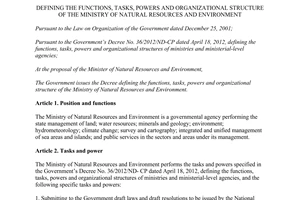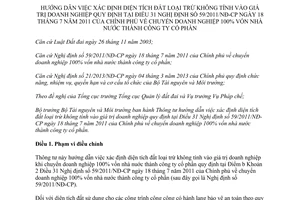Nội dung toàn văn Circular No. 26/2013/TT-BTNMT the determination of land areas to be excluded from the value of enterprises
|
THE MINISTRY OF NATURAL RESOURCES AND ENVIRONMENT |
SOCIALIST
REPUBLIC OF VIETNAM |
|
No. 26/2013/TT-BTNMT |
Ha Noi, September 26, 2013 |
CIRCULAR
GUIDING THE DETERMINATION OF LAND AREAS TO BE EXCLUDED FROM THE VALUE OF ENTERPRISES UNDER ARTICLE 31 OF THE GOVERNMENT’S DECREE NO. 59/2011/ND-CP OF JULY 18, 2011, ON TRANSFORMATION OF WHOLLY STATE-OWNED ENTERPRISES INTO JOINT-STOCK COMPANIES
Pursuant to the November 26, 2003 Land Law;
Pursuant to the Government’s Decree No. 59/2011/ND-CP of July 18, 2011, on transformation of wholly state-owned enterprises into joint-stock companies;
Pursuant to the Government’s Decree No. 21/2013/ND-CP of March 4, 2013, defining the functions, tasks, powers and organizational structure of the Ministry of Natural Resources and Environment;
At the proposal of the General Director of Land Administration and the director of the Legal Affairs Department;
The Minister of Natural Resources and Environment promulgates the Circular guiding the determination of land areas to be excluded from the value of enterprises under Article 31 of the Government’s Decree No. 59/2011/ND-CP of July 18, 2011, on transformation of wholly state-owned enterprises into joint-stock companies.
Article 1. Scope of regulation
This Circular guides the determination of land areas to be excluded from the value of enterprises when transforming wholly state-owned enterprises into joint-stock companies as provided at Point b, Clause 2, Article 31 of the Government’s Decree No. 59/2011/ND-CP of July 18, 2011, on transformation of wholly state-owned enterprises into joint-stock companies (below referred to as Decree No. 59/2011/ND-CP).
The Prime Minister shall decide on the exclusion of land areas used for public works with safety protection corridors in accordance with the land law from the value of wholly state-owned enterprises currently using them.
Article 2. Subjects of application
1. State management agencies; natural resources and environment agencies and related organizations and individuals.
2. To-be-equitized enterprises specified in Article 2 of Decree No. 59/2011/ND-CP (below referred equitized enterprises).
Article 3. Land areas to be excluded from the value of equitized enterprises Land areas to be excluded from the value of equitized enterprises under Point b, Clause 2, Article 31 of Decree No. 59/2013/ND-CP are those allocated by the State without collection of land use levy under the land law for use for production or provision of public-utility or public welfare products or services, specifically as follows:
1. Land areas used for research, testing and experimental activities in agriculture, forestry, aquaculture or salt making.
2. Land areas for building resettlement houses in state-invested projects.
3. Land areas for building non-commercial parking facilities.
4. Land areas for building non-commercial cultural, health, education and training and physical training and sports facilities serving public interests, including:
a/ Land areas for building head offices of news and press agencies, radio and television stations, parks, flower gardens, recreation and entertainment centers, clubs, cultural houses, commune post-cultural points, museums, exhibition halls, libraries, cinemas, circuses, theaters, literary and artistic creation centers, art display halls and head offices of art troupes; land areas for building memorial monuments and steles under competent state agencies’ permission.
b/ Land areas for building hospitals, clinics, maternity homes, health rehabilitation establishments, functional rehabilitation establishments, HIV/AIDS treatment establishments and other health establishments licensed by competent state agencies (excluding land areas used for business and service purposes such as those for building clinics providing high-quality health services, drug stores, lodging facilities, restaurants and parking lots);
c/ Land areas for building education and training works, including preschools, general schools, vocational secondary schools, colleges, universities and training and vocational institutions (including also student dormitories) licensed by competent state agencies (excluding land areas used for business purposes such as those for building lodging facilities, restaurants and parking lots);
d/ Land areas for building stadiums and facilities for physical training and sports activities licensed by competent state agencies (excluding land areas for building ticket booths, souvenir shops, physical training and sports equipment shops, hospitals, lodging facilities, restaurants and parking lots);
dd/ Land areas for building care centers for the elderly, people with disabilities and disadvantaged children; reformatories and dignity rehabilitation centers; drug detoxification establishments; and funeral homes;
e/ Land areas with historical-cultural relics and scenic places ranked or protected under decisions of People’s Committees of provinces or centrally run cities (below referred to as provincial-level People’s Committees) (excluding land areas for building ticket booths, lodging facilities, restaurants, souvenir shops, parking lots and other facilities used for sightseeing, tourist and recreation and entertainment services);
g/ Land areas used as waste and garbage sites or used for building waste and garbage treatment facilities serving local communities.
5. Land areas for building common-use infrastructure facilities in industrial parks under approved projects.
6. Land areas used for public purposes under projects to build urban centers, residential areas or production and business complexes with land areas used for different purposes other than industrial parks, economic zones and hi-tech parks, including:
a/ Land areas for building roads linked to public roads without barriers or any other obstacles erected to restrict travel within the premises of investment works or projects;
b/ Land areas used as parks, recreation and entertainment centers, education, training, health, culture, and physical training and sports establishments or other establishments which operate for non-commercial purposes and serve people living inside or outside urban centers or rural residential areas.
Article 4. Determination of land areas to be excluded from the value of equitized enterprises
1. When elaborating land use plans, equitized enterprises shall determine land areas to be excluded from their value as specified in Article 3 of this Circular.
Such land areas are determined according to the Appendix to this Circular (not translated) and must be shown on cadastral maps or cadastral survey papers, for areas without cadastral maps.
2. Equitized enterprises shall send land use plans, together with statistics on land areas to be excluded from their value as specified Clause 1 of this Article, to provincial-level Natural Resources and Environment Departments of the localities where such land areas are located for consideration and submission to provincial-level People’s Committees for approval.
3. Within 15 days after receiving a valid and complete dossier, a provincial-level Natural Resources and Environment Department shall assume the prime responsibility for, and coordinate with related departments and sectors in, reviewing and making a written proposal to the provincial-level People’s Committee for approval of land areas to be excluded from the value of the equitized enterprise.
4. Within 5 working days after receiving the provincial-level Natural Resources and Environment Department’s written proposal, the provincial-level People’s Committee shall approve the land areas to be excluded from the value of the equitized enterprise in the land use plan.
Article 5. Implementation responsibilities
1. Provincial-level People’s Committees shall direct provincial-level Natural Resources and Environment Departments in assuming the prime responsibly for, and coordinate with related departments and sectors in, reviewing land areas to be excluded from the value of equitized enterprises; and approve land areas to be excluded from the value of equitized enterprises in land use plans.
2. The General Department of Land Administration shall examine, supervise and urge the implementation of this Circular.
3. Provincial-level Natural Resources and Environment Departments shall:
a/ Guide equitized enterprises to determine land areas to be excluded from the their value in land use plans;
b/ Assume the prime responsibility for, and coordinate with related departments and sectors in, reviewing land areas to be excluded from the value of equitized enterprises in land use plans.
4. Wholly state-owned enterprises undergoing equitization under Decree No. 59/2011/ND-CP shall determine land areas to be excluded from their value according to this Circular.
5. For equitized enterprises with equitization plans approved before the effective date of this Circular, the approved equitization plans may be implemented if the determination of land areas to be excluded from their value complies with Article 3 of this Circular.
In case equitization plans have been approved but the determination of to-be excluded land areas fails to comply with Article 3 of this Circular, if the equitized enterprises have not yet sold their shares, their value must be adjusted and re-announced .
Article 6. Effect
This Circular takes effect on November 11, 2013.
Any difficulties and problems arising in the course of implementation should be reported in writing to the Ministry of Natural Resources and Environment for consideration and decision.-
For the Minister of Natural Resources and Environment
|
|
DEPUTY MINISTER |
------------------------------------------------------------------------------------------------------
This translation is made by LawSoft,
for reference only. LawSoft
is protected by copyright under clause 2, article 14 of the Law on Intellectual Property. LawSoft
always welcome your comments



